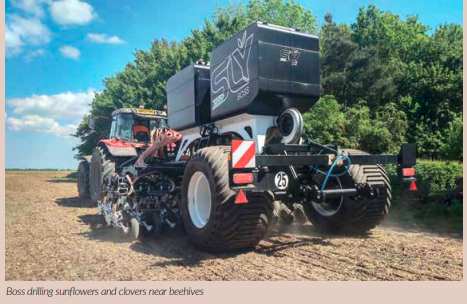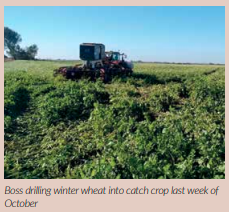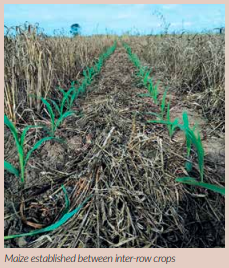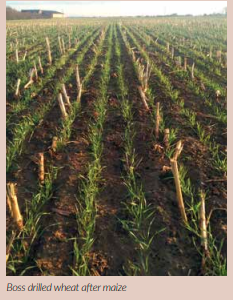
Going into my second year as a farmer I feel a lot more confident than I did last year. I have learned what soils I have, what challenges I face, and the exciting times ahead for UK agriculture and decided on a long-term approach to improve my soil health. This year we are growing Sugar Beet, Maize, Triticale, OSR, Winter Wheat, Spring Barley and a trial of Strip till Pumpkins, Butternut Squash, Dwarf beans and veg (for which we will repeat the trials at Groundswell which will be on display). I have been extremely lucky starting my farming career with a very dry year, I farm at or below sea level on 30-50% clay, 30-50% silt soils, it holds water like you would not believe! Drainage will be an issue in the future but I have an affordable plan for that and don’t see it as a major risk to my crops, heavy tillage is not the solution! Localised pipes/trenches and the use of light/ low disturbance lifting/aeration when conditions are right.

I am very fortunate to be able to use our latest No-till and Strip till machines on our farm and I love pushing the boundaries of both technologies to see what is possible in the future. Having no prior farming experience what I have already learnt is diversity is key, with a high diversity and a rule to work with and not against nature makes everything more resilient. I am also working with a neighbour to share machinery, knowledge and resources, that is invaluable. Being able to use and push the limits of our machines puts me in a good position to advise our customers and hold farm walks. Our Winter Wheat and Triticale was all no-till drilled, some of it had some lifting/aeration and nearly all had a catch crop between harvest and drilling (last week October). We drilled around 60% our wheat with Nurture N (Molasses mix) and Bacillus microbes, this was placed very accurately into the furrow with our Exadose system. I don’t expect an annual benefit from this but I plan to monitor the fields that have regular applications. Can I quantify the benefits, we will see…

We fortunately decided to scale back OSR to 23 Ha from 65, we strip tilled into triticale stubble (something I wish I had not done, we should have no-tilled not strip tilled to retain moisture). I used the Stripcat to also sow an interrow companion of buckwheat, white clover and spring beans, beans drilled deeper and clover + buckwheat shallow. We then precision planted the OSR in between. We lost 12 hectares of the crop to CFSB. The remaining 11 Ha looks really good. The failed area we were left with a great cover crop! The companions all did well, in particular the white clover, which is now half way up the OSR crop. It may present a harvest issue, if I feel that it will we will swath it rather than direct cut. I hope to then keep the White Clover permanently, I am testing some new designs/equipment to manage it in the living crop and supress it. There is no doubt in the battle against black grass, that Beneficial’s help supress it, purely trying to farm bare ground, stale seedbeds and rely on Glyphosate is not in my opinion the long term solution.
Establishing clovers on heavy soils in a dry year has been tough, however I have learnt a little about what works and what doesn’t. We have Crimson + White clover growing on a 6 metre strip in one field that is now Forage Triticale. I established it ahead of spring oats in March 2018. We have managed to keep it alive through 2 crops now and although I have seen some minor negative impacts on the crop, if it is supressed either chemically or mechanically predrilling the cash crop I really think we could roll this out over a larger area for 2020-2022. Our Sugar Beet and Maize is all established using Strip till. We till the ground in the autumn and establish cover crops interrow to the cultivated strips. We can sow covers through 3 coulters in the interrow meaning we can establish a deep drill seed in the middle and shallower seeds either side. This system has real potential going forward with the loss of chemistry.

We have the benefit of being able to grow 2 crops usually associated with heavy soil degrading tillage but instead I believe we are improving our soils even with the big Carbon and K offtake associated especially with Maize. Last year we grew 65 Hectares of Maize and only 24 hectares of that required a selective herbicide after planting. We also went back in the maize at V3 growth stage and trialled under sowing IRG and Vetch, which given the dry year had limited success… Sugar beet is much trickier on such heavy soil, but my stubbornness means we will get there, its just requiring more R+D and though to get an even stand and hold 100,000 population. The planter we use for precision crops has control systems never seen in Europe until now, depth, spacing and fertilisation is all controlled very accurately.

Our Veg plot trial was strip tilled in the autumn and White clover and rye was established, we then re-stripped and are planting pumpkins, squash, brussel sprouts, dwarf beans, sweetcorn and cauliflower, all while trying to keep the white clover as a beneficial and remove the need for selective herbicides. We are donating the produce to a local food charity this year, but we will see if there is commercial potential for this “low carbon”, “soil regen” fresh produce. We must as humans find ways to also grow fresh produce sustainably as well as Cereal crops. Farming to improve my soil is not something I feel is fashionable or trendy, it makes commercial sense. With a mortgage to 2051 and a son 14 weeks old, I feel deeply responsible to improve and regenerate my soils to hand over a profitable and sustainable business to the next generation. There are many farmers in the UK with similar thoughts and some fantastic groups to join and learn, we must think positively and embrace the future ahead.
